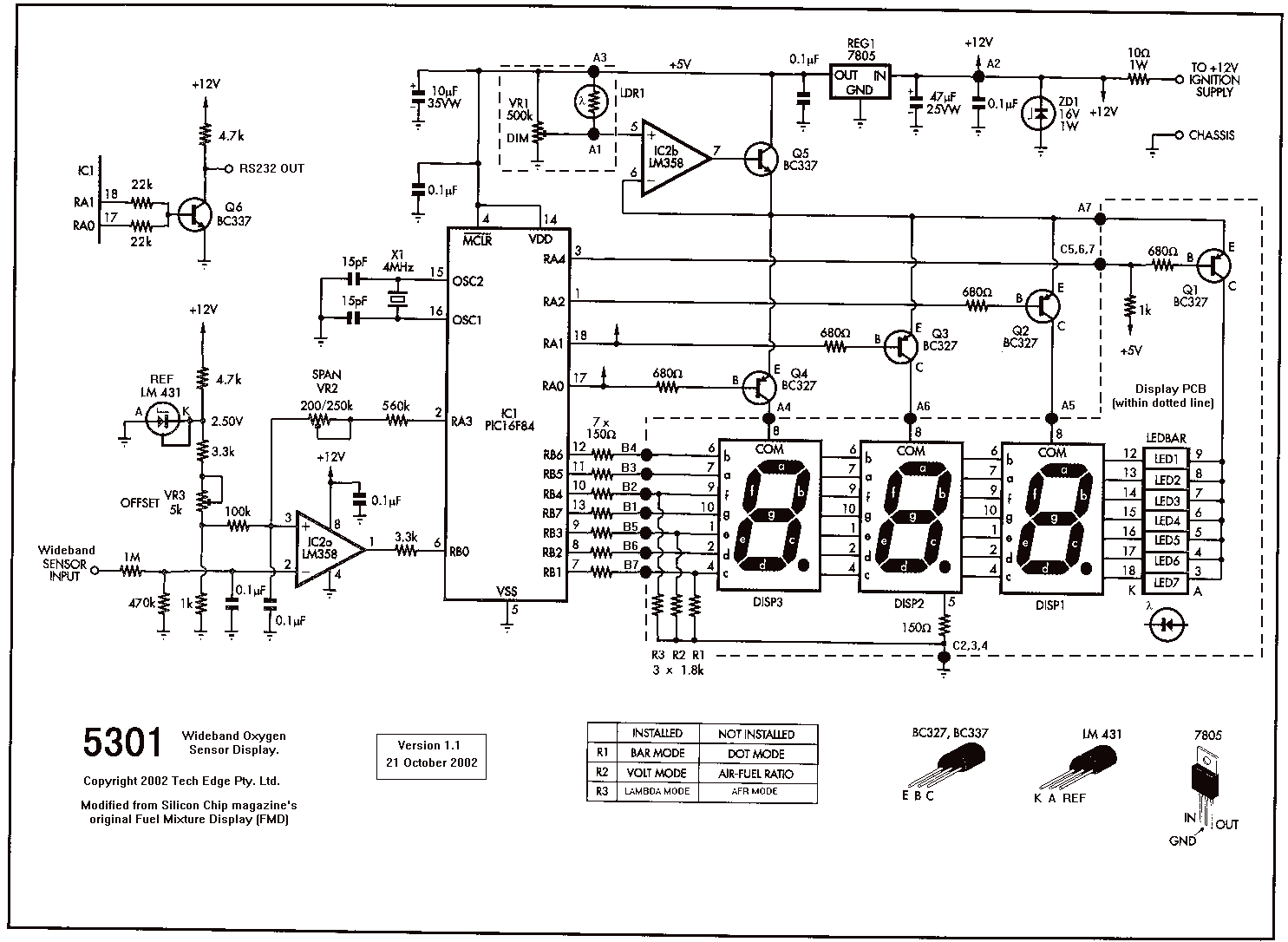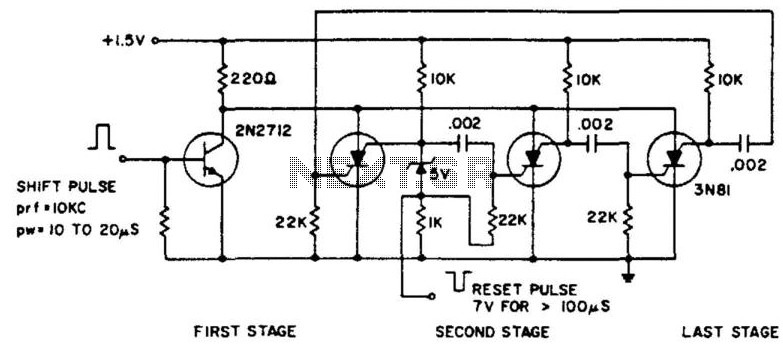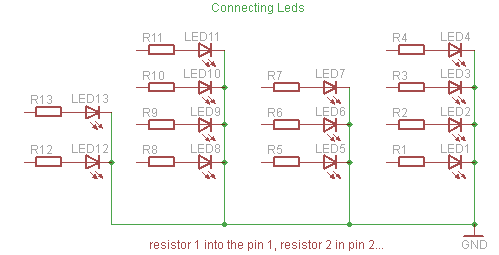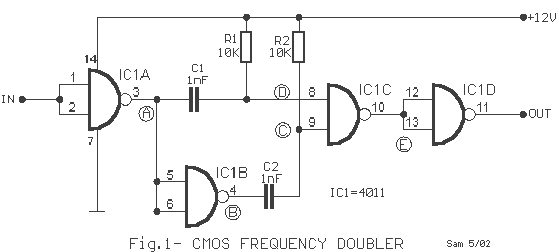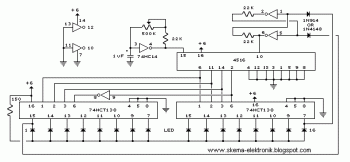
BINARY DECIMAL LED DISPLAY VERSIONS OF THE SIMPLE FREQUENCY COUNTER
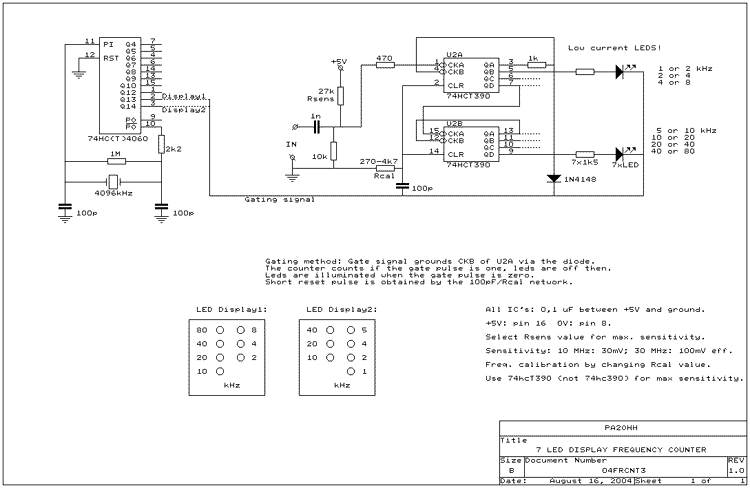
Alternative display methods exist beyond the original 8 LED frequency counter, potentially offering improved readability and a more suitable format for QRP equipment. This document presents examples of binary decimal displays. Typically, the counter omits the MHz position, focusing solely on the kHz position to read the VFO frequency within a 100 kHz segment. This counter utilizes only 7 LEDs to indicate frequency within a 100 or 50 kHz segment, beginning the count at zero for each multiple of 100 or 50 kHz. Gating occurs after the first /2 divider. In this design, the preamplifier is removed, and 74HCT390 chips replace the 74HC390 to enhance sensitivity. The first /2 divider is calibrated for optimal sensitivity using a DC bias voltage, with gating performed post this divider. It is also feasible to employ 74HC chips along with the RF preamplifier, which would be powered by the 5V supply rather than the gating pulse. This configuration prevents the RF amplifier from being switched on and off by the gating signal, which could otherwise affect the VFO frequency due to load variations. The least significant LED (representing 2 or 1 kHz) functions as an analog scale, gradually changing brightness with frequency adjustments, thus providing a more accurate frequency reading than the LED value suggests. The original 8 LED counter's 74HC4040 is substituted with a 74HC390, which contains two /10 dividers, allowing for a new display of 2x4 LEDs instead of the previous 1x8 LED setup. A 74HC00 is incorporated, utilizing one NAND gate as an RF preamplifier to boost sensitivity and serve as a buffer between the VFO and counter, while another NAND acts as an RF gate switch to control the counter. The remaining two NAND inputs are grounded. The use of a 74HC00 in place of the transistor amplifier resolves settling time issues associated with the original two-chip frequency counter. Although the chip is less expensive than the transistor, it requires higher supply current. The 74HC4060 oscillator, paired with a 4096 kHz crystal, generates a frequency of 500 Hz. Only the +5V half-period is utilized for counting; during the +0V half-period, the LEDs display the frequency, while they remain off during the +5V half-period when the 74HC390 counts the frequency. The counting period begins with a short reset pulse from the 100 pF/Rcal differential network resetting the 74HC390. Gating is critical, as a transition from 1 to 0 at the 74HC00 gate may lead to an extra count. This issue does not arise when the gate switches off, as the output transitions from 0 to 1 (or remains at 1). However, when the gate switches on while the input is 1, the output changes from 1 to 0. The reset pulse remains active during this transition, preventing the additional count. Calibration typically involves adjusting the crystal frequency with a trimmer, but in this case, the 100 pF capacitors lower the oscillator frequency below the crystal frequency, resulting in a slightly prolonged gating pulse. The frequency measurement duration corresponds to the gating pulse length minus the reset pulse. Calibration of the frequency counter is achieved by modifying the reset pulse length, which is dependent on the Rcal value. Selecting the appropriate Rcal value ensures accurate display of a reference frequency. At 30 MHz, the frequency error was +300 Hz, while at 10 MHz, it was 100 Hz. The accuracy in the MHz position matches that of the kHz position, as the same gating and reset pulses are employed. The total supply current, including a 78L05 stabilizer, is 10 mA with an input signal and 50 percent of the LEDs illuminated, rising to 25 mA without an input signal due to the higher supply current of the 74HC00 in the absence of an input signal.
This frequency counter circuit is designed to provide a clear and accurate frequency readout for amateur radio applications, particularly in QRP setups. The use of 74HCT390 chips enables more precise counting, and the dual /10 divider configuration allows for a more efficient LED display. The RF preamplifier, implemented with a 74HC00, enhances sensitivity while eliminating the settling time issues associated with traditional transistor amplifiers. This design focuses on achieving optimal performance and accuracy, ensuring reliable frequency measurements across various operating conditions. The careful calibration process, reliant on adjusting the reset pulse length, further enhances the counter's accuracy, making it a valuable tool for frequency monitoring in QRP equipment. Overall, this circuit represents a significant advancement in frequency counter technology, providing users with a high level of functionality and precision.There are other display methods than the original 8 led frequency counter has. They are perhaps easier to read and may have a format that fits better to the front of your QRP equipment. Here some examples of binary decimal displays are given. Mostly the the counter is made without the MHz position, only the kHz position is used to read the VFO fre
quency within a 100 kHz segment. This counter uses only 7 leds for reading the frequency in a 100 or 50 kHz segment. The counter starts counting at zero at each multiple of 100 or 50 kHz. Gating is done after the first /2 divider. In this version, also the preamplifier is deleted and 74HCT390 chips are used instead of a 74HC390 for maximum sensitivity. The first /2 divider is adjusted for maximum sensitivity with a DC bias voltage. Gating is done after this first /2 divider. Of course it is also possible to use 74HC chips plus the RF preamplifier. In this case, the RF preamplifier is supplied by the 5V supply and not by the gating pulse. The advantage is that the RF amplifier is not switched on/off by the gating signal which might influence your VFO frequency due to the varying load.
The least significant led (2 or 1 kHz) works like an analog scale. It slowly varies in brightness when the frequency is changed. Therefore, the frequency reading is much better than the value of that led. The 74HC4040 in the original 8 led counter is replaced by a 74HC390. This chip has two /10 dividers so that we will have that new display with 2x4 leds instead of the 1x8 led display. A 74HC00 (do not use a HCT) is added, one NAND is used as RF preamplifier to increase the sensitivity and as buffer between the VFO and counter, another as an RF gate switch to start and stop the counter.
The unused inputs of the two remaining NAND`s are grounded. Using a 74HC00 instead of the transistor amplifier eliminates the problems with the settling time of the RF transistor amplifier of the original two chip frequency counter. The chip is even cheaper than the transistor but needs more supply current! The 74HC4060 oscillator with the 4096 kHz X-tal generates a frequency of 500Hz. Only the +5V half period is used for counting. During the +0V half period, the leds are displaying the frequency, during the +5V half period, they are off and the 74HC390 is counting the frequency.
At the beginning of the counting period, the 74HC390 is reset by the short reset pulse from the 100 pF/Rcal differential network. The gating is very critical as a 1 to 0 transition from the 74HC00 gate will cause an extra count. This does not occur when the gate switches off, then the output goes from 0 to 1 (or 1 to 1). But when the gate switches on while the input is 1, the output of the gate is changes from 1 to 0. However, during this moment the reset pulse is active, preventing that extra count. Normally, the calibration is done by adjusting the crystal frequency with a trimmer. But not here! Due to the 100pF capacitors, the oscillator frequency is lower than the crystal frequency. The resulting gating pulse is a little too long. But the frequency measurement time is the length of the gating pulse minus the reset pulse. Calibration of the frequency counter is done by changing the length of the reset pulse (depending on Rcal value).
Select the Rcal value for a correct display of a reference frequency. At 30 MHz, the frequency error was +300 Hz. At 10 MHz, the error was 100 Hz. In the MHz position, the accuracy is the same as in the kHz position because the same gate pulse and reset pulse are used. Supply current including a 78L05 stabilizer is 10 mA with an input signal and 50 percent of the leds on, 25 mA without input signal as the supply current of the 74HC00 is much higher without an input signal.
🔗 External reference
This frequency counter circuit is designed to provide a clear and accurate frequency readout for amateur radio applications, particularly in QRP setups. The use of 74HCT390 chips enables more precise counting, and the dual /10 divider configuration allows for a more efficient LED display. The RF preamplifier, implemented with a 74HC00, enhances sensitivity while eliminating the settling time issues associated with traditional transistor amplifiers. This design focuses on achieving optimal performance and accuracy, ensuring reliable frequency measurements across various operating conditions. The careful calibration process, reliant on adjusting the reset pulse length, further enhances the counter's accuracy, making it a valuable tool for frequency monitoring in QRP equipment. Overall, this circuit represents a significant advancement in frequency counter technology, providing users with a high level of functionality and precision.There are other display methods than the original 8 led frequency counter has. They are perhaps easier to read and may have a format that fits better to the front of your QRP equipment. Here some examples of binary decimal displays are given. Mostly the the counter is made without the MHz position, only the kHz position is used to read the VFO fre
quency within a 100 kHz segment. This counter uses only 7 leds for reading the frequency in a 100 or 50 kHz segment. The counter starts counting at zero at each multiple of 100 or 50 kHz. Gating is done after the first /2 divider. In this version, also the preamplifier is deleted and 74HCT390 chips are used instead of a 74HC390 for maximum sensitivity. The first /2 divider is adjusted for maximum sensitivity with a DC bias voltage. Gating is done after this first /2 divider. Of course it is also possible to use 74HC chips plus the RF preamplifier. In this case, the RF preamplifier is supplied by the 5V supply and not by the gating pulse. The advantage is that the RF amplifier is not switched on/off by the gating signal which might influence your VFO frequency due to the varying load.
The least significant led (2 or 1 kHz) works like an analog scale. It slowly varies in brightness when the frequency is changed. Therefore, the frequency reading is much better than the value of that led. The 74HC4040 in the original 8 led counter is replaced by a 74HC390. This chip has two /10 dividers so that we will have that new display with 2x4 leds instead of the 1x8 led display. A 74HC00 (do not use a HCT) is added, one NAND is used as RF preamplifier to increase the sensitivity and as buffer between the VFO and counter, another as an RF gate switch to start and stop the counter.
The unused inputs of the two remaining NAND`s are grounded. Using a 74HC00 instead of the transistor amplifier eliminates the problems with the settling time of the RF transistor amplifier of the original two chip frequency counter. The chip is even cheaper than the transistor but needs more supply current! The 74HC4060 oscillator with the 4096 kHz X-tal generates a frequency of 500Hz. Only the +5V half period is used for counting. During the +0V half period, the leds are displaying the frequency, during the +5V half period, they are off and the 74HC390 is counting the frequency.
At the beginning of the counting period, the 74HC390 is reset by the short reset pulse from the 100 pF/Rcal differential network. The gating is very critical as a 1 to 0 transition from the 74HC00 gate will cause an extra count. This does not occur when the gate switches off, then the output goes from 0 to 1 (or 1 to 1). But when the gate switches on while the input is 1, the output of the gate is changes from 1 to 0. However, during this moment the reset pulse is active, preventing that extra count. Normally, the calibration is done by adjusting the crystal frequency with a trimmer. But not here! Due to the 100pF capacitors, the oscillator frequency is lower than the crystal frequency. The resulting gating pulse is a little too long. But the frequency measurement time is the length of the gating pulse minus the reset pulse. Calibration of the frequency counter is done by changing the length of the reset pulse (depending on Rcal value).
Select the Rcal value for a correct display of a reference frequency. At 30 MHz, the frequency error was +300 Hz. At 10 MHz, the error was 100 Hz. In the MHz position, the accuracy is the same as in the kHz position because the same gate pulse and reset pulse are used. Supply current including a 78L05 stabilizer is 10 mA with an input signal and 50 percent of the leds on, 25 mA without input signal as the supply current of the 74HC00 is much higher without an input signal.
🔗 External reference
